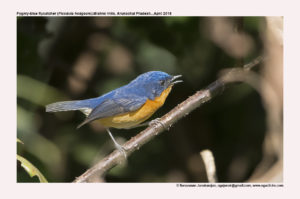Pygmy-blue Flycatcher

Pygmy Blue Flycatcher Muscicapella hodgsoni
Etymology:
- Muscicapella: diminutive degree from genus Muscicapa – Flycatchers
- Hodgsoni : Named after Englishman Brian Houghton Hodgson (1800–1894)
Distribution in India: Resident of Himalayas and North East India.
Description:Size of 9–10 cm. It is a tiny, small-billed and short-tailed, arboreal flycatcher, resembling a warbler in actions. The male of nominate race has bright ultramarine-blue crown and upperparts, including edges of upperwing-coverts, inner flight-feathers and tail; lower forehead and lores to behind eye are blackish, forecrown to over eye are paler or brighter blue. It is almost entirely deep orange below, paler on lower belly and whitish on undertail-coverts. The iris is dark brown; bill is black; legs are bluish or purplish-grey. The female has olive-brown head and upperparts, slightly warmer or more rufous-tinged on edges of flight-feathers, rump and uppertail-coverts, tail is dull brown, narrow pale buffish eyering, mostly rufous-tinged orange-buff below, usually whiter on chin and throat, belly is also white, bill is as male but with slate-grey base of lower mandible.
Habitat:It is found in breeding season in dense, montane broadleaf forests and high-altitude elfin forest and subalpine scrub. It is found from 2100 m up to 3500 m. In non-breeding season it is found in tall deciduous forest, secondary scrub at forest edges, clearings and along streams at lower levels in foothills and adjacent plains. It comes down to 300–750 m.
Food habits: It eats small invertebrates, like flies. It is found in pairs, or solitary in non-breeding season. It joins mixed-species foraging flocks. It is inconspicuous and easily overlooked in forest canopy. It forages also in lower levels in thickets and scrub. It forages rapidly through foliage of lower and middle levels of forest, inspecting foliage, branches and epiphyte clumps, and making aerial pursuit of flushed insects. It flicks wings and cocks its tail while drooping the wings.
Breeding habits: They breed in Mar to Jul in India. Both adults gather nest material, but nest is built by female alone. The nest is an open cup of moss and black plant fibres, placed above ground in thick stems of creeper growing around tree stump.